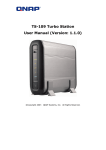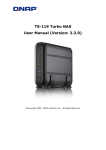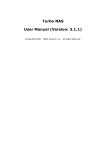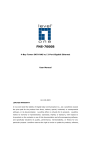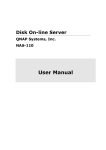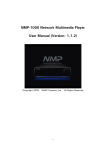Download APC NAS-2100 User's Manual
Transcript
Disk On-line Server QNAP Systems, Inc. NAS-2100 User Manual Broadband Network Attached Storage NAS-2100 User Manual (Version: 4.1.4) ©Copyright 2005. QNAP Systems, Inc. All Rights Reserved. March 29, 2005 2 CUSTOMER SERVICE For the contact details of customer service and technical support, please refer to the registration card. LIMITED WARRANTY In no event shall the liability of QNAP Systems, Inc. (QNAP) exceed the price paid for the product from direct, indirect, special, incidental, or consequential software, or its documentation. QNAP offers no refunds for its products. QNAP makes no warranty or representation, expressed, implied, or statutory, with respect to its products or the contents or use of this documentation and all accompanying software, and specifically disclaims its quality, performance, merchantability, or fitness for any particular purpose. QNAP reserves the right to revise or update its products, software, or documentation without obligation to notify any individual or entity. CAUTION 1. Back up your system periodically to avoid any potential data loss. 2. Should you return any components of Disk On-line Server package for refund or maintenance, make sure they are carefully packed for shipping. Any form of damages due to improper packaging will not be compensated. 3 Table of Contents Chapter 1 Overview of Disk On-line Server ...........................................6 1.1 Introduction ...................................................................................6 1.2 Package Contents............................................................................6 1.3 System Overview ............................................................................7 Chapter 2 2.1 Installation of Disk On-line Server........................................8 Network Configuration .....................................................................8 Chapter 3 Administration of Disk On-line Server...................................9 3.1 Accessing Administration Page ..........................................................9 3.2 Server Administration .................................................................... 11 3.3 Quick Configuration ....................................................................... 12 3.4 System Settings............................................................................ 18 3.5 Network Settings .......................................................................... 21 3.6 Disk Configuration......................................................................... 29 3.7 User Management ......................................................................... 33 3.8 Network Share Management ........................................................... 37 3.9 System Tools ................................................................................ 41 3.9.1 SNMP Settings ........................................................................ 41 3.9.2 Alert Notification...................................................................... 42 3.9.3 Restart/ Shutdown................................................................... 42 3.9.4 Hardware Settings ................................................................... 43 3.9.5 UPS ....................................................................................... 44 3.9.6 System Update........................................................................ 45 3.9.7 Change Logo........................................................................... 46 3.9.8 Remote Replication .................................................................. 47 3.9.9 Virus Scan .............................................................................. 51 3.9.10 Backup/ Restore/ Reset Settings ............................................. 56 3.9.11 Backup Agent ....................................................................... 57 3.10 Statistics & Logs......................................................................... 60 Chapter 4 Accessing Disk On-line Server ............................................61 4.1 Using Microsoft Windows ................................................................ 61 4.2 Using Apple MAC OS...................................................................... 63 4.3 Using Unix/ Linux OS ..................................................................... 69 4.4 Netware Service............................................................................ 69 4.5 Using Web Browser ....................................................................... 69 4.6 Using File Transfer Protocol (FTP) .................................................... 70 Chapter 5 Disk On-line Server-Maintenance........................................72 4 5.1 Restart/ Shut down Server ............................................................. 72 5.2 Reset Administrator Password and Network Settings .......................... 72 5.3 Disk Failure or Malfunction.............................................................. 73 5.4 Power Outage or Abnormal Shutdown .............................................. 73 Appendix A LCD Panel.........................................................................74 Appendix B Web File Manager ............................................................77 Appendix C Quick Install Wizard.........................................................82 Appendix D NetBak Replicator ............................................................91 Appendix E Configuring AD Authentication.......................................102 Appendix F Messages of Hard Disk and Disk Configuration Status ...111 5 Chapter 1 1.1 Overview of Disk On-line Server Introduction Thank you for choosing Disk On-line Server (NAS). This product has the following key features: • Desktop/ Rack-mount dual form factor design • VIA Eden 400MHz/ 128MB DRAM • 2 x 3.5’’ IDE HDD • Maximum capacity up to 600GB • Supports RAID 0, 1 and JBOD storage management • 10/100 Mbps fast Ethernet port • Supports UPS management via USB port 1.2 Package Contents Your NAS package contains: • Disk On-line Server (stands inclusive) • Power cable • CAT-5 Ethernet cable • Companion CD (user manual, Quick Install Wizard and software inclusive) • Quick Installation Guide Important Notice: Please back up your disk data periodically to avoid data loss due to improper operation or disk failure of Disk On-line Server. 6 1.3 System Overview Front View LCD panel Enter button LED Indicators: Disk 1, Disk 2, and Network Down button Rear View Reset button Power button 10/100 Mbps RJ-45 Ethernet port USB ports 7 Power Connector Chapter 2 Installation of Disk On-line Server 2.1 Network Configuration By factory default, Disk On-line Server will search the network via DHCP (Dynamic Host Configuration Protocol) to detect IP address settings automatically. If your network does not support DHCP protocol, Disk On-line Server will use the default settings as below: IP Address: 192.168.0.1 Subnet Mask: 255.255.255.0 When Disk On-line Server completes its boot-up process, the LCD panel will display current IP address settings. If your network does not support DHCP protocol, you must configure your Disk On-line Server to proper LAN settings before using it for the first time. (If you are not sure about the LAN settings, please contact your network administrator). You can change the network settings of Disk On-line Server by the following ways: 1. Use the LCD panel to change the network settings. For more information, please refer to Appendix A. 2. Use Quick Install Wizard in the companion CD to change the network settings. For more information, please refer to Appendix C. 8 Chapter 3 Administration of Disk On-line Server When you have installed Disk On-line Server and connected it to the network, you can manage the server via web browser. Disk On-line Server supports Microsoft Internet Explorer 5.0 or later, and Netscape Navigator 4.5 or later. Microsoft Internet Explorer 5.5 is recommended. 3.1 Accessing Administration Page 1. Launch the web browser. Enter the IP address of Disk On-line Server to access the administration page. The IP address can also be obtained on the LCD display of Disk On-line Server (see Appendix A). 2. Run Quick Installation Wizard (see Appendix C) and double-click on an entry on the list. 9 3. Click Administration on the main page. 4. Enter the user name and password. The default administrator name and password are: User name: administrator Password: admin The first time you login Disk On-line Server, Quick Configuration page will be shown. Please refer to the Quick Configuration section for more details. 10 3.2 Server Administration There are eight main sections in server administration, which are listed below: Quick Configuration Server Name System Settings Date & Time Language Setting View System Settings TCP/IP Configuration Network Settings Microsoft Networking Apple Networking NFS Service Netware Service Web Service FTP Service View Network Settings Create Disk Volume Disk Configuration Delete Disk Volume Examine Disk Volume Format Disk Volume View Disk & Volume Status User Management Users User Groups Quota Create Network Share Management Create Create Private Network Share Assign Users Delete Property Access Control Delete SNMP Settings Alert Notification Restart / Shutdown Hardware Settings System Tools UPS System Update Change Logo Remote Replication Virus Scan Backup/ Restore/ Reset Settings Backup Agent Active Users Statistics & Logs Event Logs DHCP Logs 11 Create Create Multiple Users Change Password Create Private Network Share Assign User Groups Quota Settings Delete 3.3 Quick Configuration You can configure Disk On-line Server step by step in Quick Configuration section. 1. Enter the server name. 12 2. Change the administrator password or select to use the original password. 3. Enter the date, time and select the time zone for the server. 4. Select the language the server uses for file names. 13 5. Enter the IP address, subnet mask and default gateway for the server. 6. Select the network file services to provide on the server. 14 7. Configure disk volume on this server. 8. Configure the method of user authentication. 15 9. Manage users and user groups of this server. 16 10. Manage network shares on this server. 11. Finish. It may take several to tens of minutes to complete Quick Configuration, depending on your system settings. 17 3.4 System Settings Basic system settings include the server name, date, time, language settings, and view system settings. • Server Name Enter the name of Disk On-line Server. The server name can be 14 characters long at maximum, which can contain alphabets, numbers and hyphens (-). The server does not accept names containing empty characters, period (.), or names with only numbers. 18 • Date & Time Set the date, time, and time zone according to your location. If the settings are incorrect, the following problems may occur: 9 When using a web browser to access or save a file, the display time of the action will be incorrect. 9 The system event log time will be incorrect compared to the actual time when an action occurs. 9 NTP Server You can enable or use specified NTP server to update the date and time of the system automatically. When there is no specified IP address for the NTP server, the system will refer to internal clock for date and time settings. 19 • Language Setting Disk On-line Server will use the language specified in this section to create and display files and directories. Select the correct language to avoid the following problems: i. Unable to create files or directories in special characters. ii. Unable to display file or directory name in special characters. • View System Settings You can view all current system settings, e.g. server name, on this page. 20 3.5 1. Network Settings TCP/IP Configuration • Obtain IP address settings automatically via DHCP If your network supports DHCP, Disk On-line Server will automatically use DHCP protocol to retrieve the IP address and related information. • Use static IP address To use fixed IP address for network connection, enter the following information: 9 Fixed IP Address IP address is a 32-bit digit used to differentiate each single entity on a network. IP address is divided into four groups of eight bits separated by dots, e.g. 192.168.0.1. 9 Subnet Mask Subnet mask defines computers within the same local network. It is a 32-bit digit, e.g. 255.xxx.xxx.xxx. 9 Default Gateway Gateway is generally referred to an interchange point that connects two networks, such as LAN and WAN. 21 Primary DNS Server: Enter the IP address of primary DNS server that provides DNS service for NAS in external network. Secondary DNS Server: Enter the IP address of secondary DNS server that provides DNS service for NAS in external network. You can also configure the following settings: 9 Enable DHCP server If there is no DHCP server on your network, you can enable this option to provide IP address settings to the clients. 9 Start IP address The first IP address to be dynamically allocated for DHCP service. 9 End IP address The last IP address to be dynamically allocated for DHCP service. 9 Lease time Define the lease time for the dynamic IP address. 9 Primary DNS server When the system allocates an IP address to your computer, the primary DNS server address is also specified to it. 9 Secondary DNS Server When the system allocates an IP address to your computer, the secondary DNS server address is also specified to it. Network Speed Network speed settings provide an advanced option for configuring network speed. You can select auto-negotiation to determine network speed automatically. It is recommended to use the default setting. 22 2. Microsoft Networking Enable file service for Microsoft networking: For users using Microsoft Windows, enable this service to access the files on network share folders. Assign a workgroup name. The name can be 15 characters long at maximum but must not include the following: "+=[],;/\:|*?<>." Note: The first character cannot be a period (.). 9 Standalone Server Use local users for user authentication. 9 NT Domain Member Use Microsoft NT domain for user authentication. 9 AD Domain Member Use Microsoft AD domain for user authentication. ¾ Server Description: Describe Disk On-line Server, e.g. administrator name, department, or location of the server, for users to identify the server. Users using Disk On-line Server on the Microsoft Windows operating systems must enable Microsoft Network Services. 23 ¾ Workgroup: When configuring Disk On-line Server as standalone server, specify the workgroup the server belongs to. The workgroup is a computer group unit in Microsoft Windows network for network sharing. ¾ Domain Name: Microsoft domain name. Enter the domain name when you select NT domain or AD domain. If the local network has a WINS server installed, specify the IP address. Disk On-line Server will automatically register its name and IP address with WINS service. If you do not want to enable WINS server support, or you do not have a WINS server on your network, enter 0.0.0.0 in the field for WINS server IP address. 24 3. Apple Network To use Disk On-line Server on Apple MAC operating system, enable AppleTalk network support. If your AppleTalk network uses extended networks, and is assigned with multiple zones, assign a zone name to Disk On-line Server. If you do not want to assign a network zone, enter an asterisk (*) to use the default setting. 4. NFS Service To use Disk On-line Server on Unix/ Linux operating system computer or server, enable NFS service. Disk On-line Server supports NFS version 2.0 and 3.0. To correctly use NFS service, assign a user’s UID and IP address. Go to NFS Settings in Users of User Management for setup. When you have completed the configuration, login the system as root and use mount command to connect to the network. You can then login with other identities and access Disk On-line Server using previous NFS settings. 25 5. NetWare Service To use Novell Netware service, enable this option and enter the server name for Netware network. The server will then operate in a manner similar to a Novell NetWare 3.12 file server. To configure more options for Netware service, enable Netware service and click Advanced. • Frame Type: If you have a Novell server on your local network, select the same frame type as the server's. • Internal Network Number: This is a unique number to identify the server on a network. The system will set it to the IP address if Auto-configure option is selected. Or you may enter a unique internal network number manually. • External Network Number: This number identifies a logical network segment on a network. The system can configure it automatically, or you can set the external network number manually. 26 6. Web Service To access files on Disk On-line Server via web browser, enable Web File Manager. If Disk On-line server is connected to the Internet and uses a valid IP address, you can access files on the server by web browser from anywhere. 7. FTP Service To download files from or upload files to Disk On-line Server by using file transfer protocol (FTP), activate FTP service. 27 8. View Network Settings You can view current network settings and status in this section. 28 3.6 Disk Configuration Your Disk On-line Server can accommodate two disks at maximum. You can set the disk volume to the following configurations: 1. Single Disk Volume You can select to use a standalone disk. In case of disk crash, all data will be lost. 2. RAID 1 Mirroring Disk Volume Mirroring Disk protects your data by automatically backing up the contents of one disk onto the second disk of a mirrored pair. This protects your data if one of the disks fails. However, the storing capacity is equal to a single disk, as the second disk is used to automatically back up the first one. Mirroring disk volume is suitable for personal or corporate use to store important data. 3. RAID 0 Striping Disk Volume Striping disk combines two or more disks into one larger disk. It offers the fastest disk access but it does not have any protection of your data if the striped array fails. The disk capacity equals the number of disks in the array times the size of the smallest disk. Striping disk is usually used to maximize your disk capacity or for fast disk access but not for storing important data. 4. Linear Disk Volume You can combine two or more disks into one larger disk. During file saving, the file will be saved on physical disks sequentially but does not have a disk failure file protection function. The overall capacity of linear disk is the sum of all disks. Linear disk is generally used for storing large data and is not appropriate to use for file protection of sensitive data. 29 By factory default, Disk On-line Server is preset to one large RAID 0 disk (applicable for servers with two or more disk volumes). To use other disk configurations, the settings can be changed during the first Quick Configuration access. You can also administer your disk volume in the following ways: i. Create Disk Volume ii. Delete Disk Volume 30 iii. Examine Disk Volume 9 Disk Volume Operation Report This page shows the current status and information of disk volume operation. 31 iv. Format Disk Volume v. View Disk & Volume Status 32 3.7 User Management The files on Disk On-line Server can be shared among multiple users. For easier management and better control of users’ access right, you have to organize users, user groups and their access right control. • Users The system has created the following users by default: Administrator By default, administrator is a member of the administrator group and has access to system administration. You cannot delete administrator. Guest When you use a non-registered user name to login, the server will recognize the user as a Guest and will allow limited access. A guest does not belong to any user group. You cannot delete the user Guest or create a password. Anonymous When you connect to the server by FTP service, you can use the name to login as a guest. You cannot delete this user or change its password. You can create a new user according to your needs. The following information is required to create a new user: 33 9 User name The user name must not exceed 32 characters. It is case-insensitive and can contain double-byte characters, such as Chinese, Japanese, and Korean except: " / \ [ ] : ; | = , + * ? < >` ' 9 Password The password must be 6~16 characters long. Avoid using codes that are easily decipherable. You can perform the following settings for users: i. Create ii. Create Multiple Users iii. Change Password iv. Create Private Network Share v. Assign User Groups vi. Quota Settings vii. Delete 34 • User Groups User group is a collection of users with the same access right to files or folders. Disk On-line server has created the following user groups by default: 9 Administrators All members of administrators group have the right to perform system management. You cannot delete this group. 9 Everyone All registered users belong to everyone group. You cannot delete this group. You can manage user groups with the following options: i. Create ii. Create Private Network Share iii. Assign Users iv. Delete User groups name must not exceed 256 characters. It is case-insensitive and can contain double-byte characters, such as Chinese, Japanese, and Korean, except the following ones: " / \ [ ] : ; | = , + * ? < >` ' To properly manage security, it is very important to manage users and user groups. You may set the share access parameters of each user or user group accordingly. 35 • Quota To allocate disk volume efficiently, you can specify the quota that can be used by each user. When quota is set, users are not allowed to further use disk space once they have reached their quota limit. By default, no limitations are set for users. You can modify the following two options: 9 Enable quota for all users 9 Quota size on each disk volume 36 3.8 Network Share Management The primary purpose of network storage is file sharing. In a standard operation environment, you can create different network share folders for various types of files, or provide different file access rights to users or user groups. By factory default, a “public” share folder is created, which allows full access from all users or guests. There are four options in Network Share Management: i. Create a network share ii. Change the name, path and comment of a network share iii. Set access right for a network share iv. Remove a network share 37 • Create To create a network share, enter the following information: 9 Network share name The share name must not exceed 12 characters and cannot contain the following characters: ".+=/\:|*?<>;[]% 9 Disk volume This area shows the disk volume status. 9 Path All data are stored under the assigned path onto the disk volume. You can select “Specify path automatically” to allow the server to automatically create a new path on the disk volume to store the network share files. Or you can assign a specific path for the share folder. The path cannot exceed 256 characters and cannot contain the characters below: 9 Comment Enter a brief description for the share folder. The comment cannot exceed 128 characters. 38 • Access Control Once the network share is created, you can assign access rights to users or user groups: 9 Deny access Access to the network share will be denied when this option is selected. 9 Read only Users can read the files only on the network share when read only is assigned. 9 Full access Users with full access are allowed to read, write, create, or delete files and folders on the network share. 39 • Property and Delete To edit the property of an existing network share, select a share and click Property. You can then edit the content of that share. You can also select to delete an existing network share. Click OK to confirm the deletion or Cancel to abort. 40 3.9 System Tools System Tools enable you to optimize the maintenance and management of Disk On-line Server. 3.9.1 SNMP Settings Enable SNMP (Simple Network Management Protocol) service and complete all necessary settings to manage network components of the server by SNMP. When enabling SNMP Trap Notification, a message will be sent to a specified trap host when an error occurs. 41 3.9.2 Alert Notification Enter the e-mail address of administrator and SMTP server IP address. In case of warning or malfunction, an email will be sent to the administrator automatically. 3.9.3 Restart/ Shutdown Select to restart or shut down Disk On-line Server. 42 3.9.4 Hardware Settings You can enable or disable the hardware functions of Disk On-line Server. i. Enable LCD panel setting function To enable users to configure TCP/IP settings via the LCD panel. ii. Enable configuration reset switch By enabling this option, you can press the reset button for a few seconds to reset the administrator password and system settings to default. iii. Enable hard disk standby mode Set the minutes when there is no access to the server and the hard disk will go to standby mode. iv. Enable buzzer When buzzer is enabled, an alert sound will be played in case of system error. 43 3.9.5 UPS If your UPS device provides USB interface, you can enable UPS (uninterruptible power supply) support to protect your system from abnormal system shutdown caused by power outage. In case of utility power failure, the system will shut down automatically by probing the power status of the connected UPS unit. 9 Enable UPS support To activate the UPS support, you can select this option. You can set the shutdown timer to turn off the system automatically after the system detects the AC power is abnormal. In general, the UPS can keep supplying the power for the system for about 5 to 10 minutes. But this depends on the maximum load of the UPS and the number of the loads connected to it. UPS Model Select the UPS model from the list. If the UPS model you are using is not available on the list, please contact our technical support. UPS IP If you have selected APC UPS with SNMP for UPS model, enter the IP address of the UPS. Note: When UPS support is not enabled, the Test button will not function. 44 3.9.6 System Update To update the firmware version of Disk On-line Server, make sure you have obtained the correct version of image file. It is suggested to back up all existing data on Disk On-line Server before updating the image. The current settings will remain unchanged after the system is upgraded. 45 3.9.7 Change Logo You can choose a personal picture to display on the login page of Disk On-line Server. The size of the picture cannot exceed 20K bytes. 46 3.9.8 Remote Replication Remote Replication enables you to replicate local files to remote folders on another server. The files will be compressed before the replication process in order to save time for data transfer. Using Remote Replication Login Disk On-line Server, go to Remote Replication in System Tools. 47 i. New a. Click New to enter the following page. b. Complete all settings and click OK to save or Cancel to quit Note: To use remote replication, enable Microsoft Networking service, make sure the destination network share and directory have been created, and the user name and password are valid to login the destination folder. 48 ii. Edit a. Select the job to be edited. b. Click Edit. c. Modify the settings. d. Click OK to save or Cancel to quit. 49 iii. Delete a. Select the job to be deleted. b. Click Delete. 50 3.9.9 Virus Scan Virus scanning agent helps protect your system from being infected by viruses. You need to operate Windows NT or Windows 2000 server with virus-scanning software installed to perform real-time virus scanning. To enable virus scan support, specify the IP address of network share, the administrator ID and password. 51 Installing Virus Scan Agent Make sure virus scan agent and software are installed on the same computer which performs virus scanning before activating the agent. Follow the steps below to install Virus Scan Agent: 1. Run Install Virus Scan Agent in Disk On-line Server companion CD. 2. Click Next to continue Virus Scan Agent Setup. 52 3. Click Finish to complete. 4. A screen will pop up to show the system information the first time you have successfully installed the virus scan agent. 53 The description of the fields is as below: Fields Server Name Description Name of the network share under the protection of virus scan agent IP Address The IP address of the network share Status Connection status of the host network share with the virus scan agent: • Disconnect: Not connected to the network • Idle: Connection has been enabled but there is no file transfer for three minutes or more. • Ready: Connection has been enabled and ready to be scanned • --: User name and password have not been set up Infected Number of infected files Last Scan Time Date and time of the most recent virus scanning job Result Scanning result: OK: No files are infected • Virus Found: Virus is found. The name of the infected file(s) may not be displayed due to the scanning of other files. Go to administration page to view the name and location of the infected file(s). • Access Denied: Access to the server is denied. Authentication Failed: The login user ID is not authorized to access the folder of the network share. Path The file location on the network share 54 Enabling Virus Scan Support Go to Virus Scan of System Tools. To enable virus scan support, check the box Enable Virus Scan Support. Enter the IP address of the virus scan server and click Apply. Viewing Details of Infected Files To view the details of infected files of the network share, go to Event Logs of Statistics & Logs. A warning message will be shown in the table. 55 3.9.10 Backup/ Restore/ Reset Settings To backup the setting(s), select the appropriate option(s) and click Backup. To restore a backup settings file, click Browse to select the file and click Restore. To reset the setting(s) to factory default(s), select the appropriate option and click Reset. 56 3.9.11 Backup Agent Backup agent enables Disk On-line Server to support particular backup programs. In addition to being compatible with more tape drives and tape library, backup agent also supports backup and restoration among multiple servers on different OS. 57 Installation of Backup Agent Follow the steps below to install Backup Agent: 1. Download Backup Agent program to local disk a. Install Back Agent. Contact technical support for information of backup agent program. 2. Install Backup Agent a. Enter Disk On-line Server administration page. Go to System Tools and select Backup Agent. b. Click Browse to select Backup Agent program. c. Click Install Agent. When the installation is completed, the name of backup agent will be displayed, e.g. NetVault 6.5.3: 58 3. Configure and enable Backup Agent a. Click Enable Backup Agent. b. Enter the password for Backup Agent. c. Click Apply. The status will be shown as Running. 59 3.10 Statistics & Logs You can view the event logs of all currently online users on Disk On-line Server for system monitoring. • Active Users This page shows all users that are currently logged on to the system. • Event Logs Disk On-line Server can store thousands of recent event logs, including warning, error and information messages. In case of system malfunction, the event logs can be retrieved to help analyze the system problem. • DHCP Logs If DHCP server function is activated, you can use it to monitor all of the assigned dynamic addresses, client MAC addresses and other information. 60 Chapter 4 Accessing Disk On-line Server 4.1 1. Using Microsoft Windows You can access Disk On-line Server in Windows OS by the following ways: • By Quick Install Wizard. For further information, please refer to Appendix C. • You may also search for Disk On-line Server within the Network Neighborhood. Locate the workgroup and find the name of your Disk On-line Server. When the server is found, double-click on the server name to connect. • You may also use “Search for Computers” function to look for your Disk On-line Server in Windows. Under Windows ME or Windows 2000, please follow these steps: i. Open “My Network Places”. ii. Under the tool bar, click Search. iii. Enter the name of Disk On-line Server in Computer Name field. iv. Click Search. When Disk On-line Server is found, double click the item to access the server. 61 2. Once the connection to Disk On-line Server is successful, all listing on your available network share will be displayed. Select an appropriate network share folder and select Map Network Drive by right clicking on the item. To make the share folder available for your next start-up, check the Reconnect at logon box on the popup window and click OK to map the folder as your network drive. 62 4.2 Using Apple MAC OS If you are an Apple MAC user, you can access Disk On-line Server by the following ways: 1. Using Network Browser a. Choose “Network Browser” in Apple menu. b. In “Network Browser”, choose AppleTalk. A list of computers on the AppleTalk network will appear. Select Disk On-line Server. 63 c. Enter the login name and password, or use “Guest” to enter. Click Connect. d. When Disk On-line Server is connected, all network shares will be shown. 64 e. Choose a network share to connect. The network share will appear on the desktop. 65 2. Using Chooser a. Select Chooser on Apple menu bar. b. Click on AppleShare. The name of Disk On-line Server will appear on the right side of the window. 66 c. Use the mouse to highlight Disk On-line Server and click OK. d. Enter the correct login name and password or use “Guest” to login, and then click Connect. 67 e. All available network shares will be listed. Select a network share and click OK. f. Close the Chooser program. Double click on the icon on the desktop to access the files. 68 4.3 Using Unix/ Linux OS In addition to Microsoft and MAC OS, Disk On-line Server also supports Unixbased systems such as IBM AIX, HP-UX, Sun Solaris, Linux, Free BSD, etc. through the NFS service: Note: Configure NFS settings in User Management page for users who use this feature before proceeding to the steps below. 1. On Unix, run the command: mount -t nfs <Disk On-line Server IP address>:/<Network Share Name> <Directory to Mount> For example, if your Disk On-line server’s IP address is 192.168.0.1 and you want to link the network share folder “public” under the /mnt/pub directory, use the following command. mount -t nfs 192.168.0.1:/public /mnt/pub Note: You must login as “root” user to initiate the above command. 2. Login as the user id that you define, you can use the mounted directory to access your network share files. 4.4 Netware Service To use Novell Netware service, enable this option and enter the server name for Netware network. The server will then operate in a manner similar to a Novell NetWare 3.12 file server. 4.5 Using Web Browser Other than OS support, your Disk On-line Server also provides a convenient web file management interface that allows using a standard web browser to access your data. If you link Disk On-line Server to the Internet and use a public IP address, you can access the files on the server anywhere. For more information, please refer to Appendix B. 69 4.6 Using File Transfer Protocol (FTP) In addition to working with multiple operating systems, Disk On-line Server also supports connection via FTP. Enter the correct user name and password to connect the server or access the public share folders as guest. 1. Follow the steps below to use FTP service (based on Windows 2000 as example): 2. Click FTP. 70 3. Enter user name and password. 4. The share folder will be shown. You can then manage the folder by dragging and dropping files to it, as well as rename or delete the files. 71 Chapter 5 Disk On-line Server-Maintenance Disk On-line Server is specially designed to run 24 x 7 and be ready at all times against system crash caused by power outage. This section provides a general overview on system maintenance. 5.1 Restart/ Shut down Server Follow the steps below to restart or shut down Disk On-line Server. 1. Ask all active users of NAS to save their files and disconnect from the server. 2. Enter the administration page and select Restart/ Shutdown in System Tools. 3. Click Restart to reboot the server or Shut Down to turn off the server. You can perform these actions by the LCD panel. 5.2 Reset Administrator Password and Network Settings To reset the administrator password and network settings of Disk On-line Server, 1. Press the reset button of Disk On-line Server for a few seconds. A beep sound will be heard. 2. Login Disk On-line Server with the default user name and password: User name: administrator Password: admin Note: To reset the system by the reset button, the option “Enable configuration reset switch” in Hardware Settings must be activated. 72 5.3 Disk Failure or Malfunction When you encounter disk malfunction or failure, please do the following: 1. Record the malfunction status or error messages. 2. Stop using the failed Disk On-line Server and turn off the server. 3. Contact customer service for technical support. Note: Your Disk On-line Server must be repaired by professional technicians, please do not try to repair the server yourself. Please back up any important files or folders to avoid potential data loss due to disk crash. 5.4 Power Outage or Abnormal Shutdown In case of power outage or improper shutdown of Disk On-line Server, the system will resume to the state before it is shut down. If your server does not function properly after restart, please do the following: 1. If the system configuration is lost, configure the system again. 2. In the event of abnormal operation of the server, contact customer service for technical support. To avoid the above situations, please back up your data periodically and make sure you have done the following: 1. Follow the instructions described in Chapter 5.1 to restart or shut down the server. 2. If there is an anticipated power outage, back up important data and turn off the server properly until power supply is resumed. 73 Appendix A LCD Panel Displayed Information When Disk On-line Server is turned on, the server name and IP address will be shown. System name NAS-2100 172.17.26.19 IP address Button A Button B Check disk information and firmware version 1. Press button B to view disk information, i.e. number of disks and disk size. DISK NUMBER: 2 SIZE: 76333.36MB 2. Press to view disk information Press button B again to view the server model and firmware version. NAS-2100 4.1.4 (0120) Press to view model and firmware version 74 System Setting Function 1. Press button A for two seconds to enter configuration page. PRESS 2 SECONDS FOR CONFIG. PAGE 2. Press for 2 seconds to enter configuration page Press button B to select an item: NETWORK SETTINGS, POWER DOWN, REBOOT SYSTEM, and EXIT. SELECT 1: NETWORK SETTINGS Click this button to select an item to configure Network Settings Enter NETWORK SETTINGS configuration page and press button B to select one of the following options. The one marked with * means it is being used for connection. • DHCP DHCP will obtain IP address automatically. • STATIC IP Press button A to select STATIC IP. Then configure the IP address. i. SET STATIC IP Press button B to enter 0~255 and press button A to set the next number for the IP address. ii. SET NETMASK Follow the above procedure to set the netmask address. iii. SET GATEWAY Follow the above procedure to set the gateway address. iv. SELECT STATIC IP Press button B to select YES or NO. When YES is selected, you will be asked to restart the system. • EXIT To return to the previous menu. 75 POWER DOWN Press button B to select POWER DOWN and press button A to confirm shutting down Disk On-line Server. SELECT 2: POWER DOWN REBOOT SYSTEM Press button B to select REBOOT SYSTEM and press button A to confirm restarting the system. SELECT 3: REBOOT SYSTEM Exit Configuration Page-EXIT Press button A and select EXIT, then press the button again to confirm exiting the configuration page. SELECT 4: EXIT EXIT CONFIG PAGE Press this button to select EXIT Press again to confirm 76 Appendix B Web File Manager Using Web File Manager Launch the web browser and go to Disk On-line Server home page. Select Web File Manager and enter the correct login name and password. You may also enter “guest” in the login name field with no password to access the network shares on Disk On-line Servers as an anonymous guest. Note: Make sure a network share has been created before using Web File Manager. Select an existing network share for management. 77 You can organize network share folders of Disk On-line Server. With Web File Manager, you can upload, rename, or delete files and folders in the network shares. • View files online Click on a file displayed on the web page. The information of the file will be displayed. If your browser does not support the file format, the download window will pop up automatically. Once the file is downloaded, you can open it on your computer. • • • Create folder i. Select a network share or folder in which you want to create a new folder. ii. Click iii. Enter the name of the new folder and click OK. (Create Folder) on the toolbar. Rename file or folder i. Select a file or folder to rename. ii. Click iii. Enter the new file or folder name and click OK. (Rename) on the toolbar. Delete file or folder i. Select a file or folder to delete. ii. Click iii. Confirm to delete the file or folder. (Delete) on the toolbar. To delete all files and folders, click (Select All) and then (Delete). 78 • • • Upload file i. Open the folder to upload file to. ii. Click Browse to select the file. iii. Click Upload. Download file i. Select a file to download. ii. Right click the mouse and select “Save As” to save the file. Logout (Logout). To exit Web File Manager, click 79 • Viewing Files Named in Chinese To view files named in Chinese, you may have to configure the browser settings. Take Internet Explorer as an example, follow the steps below to configure the settings. 1. Click on Tools in IE browser. 2. Click Internet Options. 3. Cancel this option. 4. Click OK. 5. Restart the browser. 80 Web File Manager Icons Icon Description Up-return to the parent folder Refresh-reload the current page Home-return to network share list home page Create folder Rename file or folder Delete file or folder Select all Cancel selection Logout Full access network share folder Read-only network share folder Malfunction network share folder 81 Appendix C Quick Install Wizard Quick Install Wizard enables you to search for all available Disk On-line Servers within the local network, and view the server name, IP address, and workgroup etc. You can also configure the disk name, date and time, etc. via Quick Install Wizard. Screenshot Name of Disk Online Server Windows workgroup joined by Disk On-line Server IP address of Disk On-line Server System version Exit the program Configure the server name, time and network settings of Disk On-line Server View the details of selected Disk On-line Server Map network drive for the server 82 Refresh the search results within the network View help message for Quick Install Wizard Operation 1. Configure Disk On-line Server Select a Disk On-line Server displayed on Quick Install Wizard and click Configure. Enter the administrator password. Upon successful login, the following screen will appear. Enter the configuration values and click OK. 83 Set the name, date and time for Disk On-line Server. The length cannot exceed 14 characters. The system will obtain IP address automatically. To use fixed IP address for connection, enter the IP address, subnet mask and gateway for the server. For further configuration of the system, please login the administration page of Disk On-line Server via web browser. Note: You may have to restart Disk On-line Server after changing the network configuration. 84 2. View Disk On-line Server details Select a Disk On-line Server available on Quick Install Wizard and click Details. The following screen will be shown: 85 3. Map drive a. Select a Disk On-line Server and click Map Drive. b. Select the correct network share and click Map Network Drive. Then select the drive letter for connection. 86 c. Enter the password for the network drive. 87 4. Search for all available Disk On-line Server again To refresh the search results, click Refresh to display all available servers within the network. 88 5. Help Click Help to view the instructions of Quick Install Wizard. 89 6. Enter the home page of Disk On-line Server Double click on Disk On-line Server to enter the administration page. 90 Appendix D NetBak Replicator NetBak Replicator is a program installed in user’s system (Windows only) for data backup. You can upload any files or folders to server and back up the data. Main Functions 1. Backup • File Filter You can select particular file types to be excluded from backup. The system will filter all files belonging to these file types when backing up data. • Schedule You can specify a schedule for backing up data with this option, e.g. 12:00 every day or 05:00 every Saturday. • Monitor When this option is enabled, the system will upload all files or folders to the server instantly for backup when the files or folders are modified. 2. Restore Select this option to restore backed up data to the original location of the file or to a new directory. 3. Log Enable this option to record events of NetBak Replicator, e.g. the time when NetBak Replicator starts and terminates, Restore and Monitor, backup time and original location of all files, etc. 91 Installing Netbak Replicator 1. Run Install NetBak Replicator in the companion CD. 92 2. Follow the steps to install NetBak Replicator. Then click Finish. 3. Upon successful installation, a shortcut icon Desktop. 93 will be shown on the Using NetBak Replicator 1. Create a share folder for backup in NAS. 2. Run NetBak Replicator. Click . All NAS and their share folders within the network will be displayed. 94 3. Select the server and share folder, or enter the IP address of NAS for data backup. Then click OK. Note: Only authorized users can access the share folders. Double click the folder. The system will prompt for user name and password to authenticate the access privilege of the users. 95 4. You can start the backup procedure upon successful connection to the NAS. • Backup Select files and folders for backup. 9 File Filter Click File Filter to select file format to be skipped from backup. Then click OK. 96 9 Schedule Click Schedule on NetBak Replicator main page. Then check the box “Enable Backup Schedule” and select the frequency and time for backup. Click OK to confirm. 97 9 Monitor Select the files and folders for monitoring. Then click Monitor. 9 Initialize Configuration When using this function, NetBak Replicator will record all current settings of the user, including whether or not monitor function is enabled. When the user login again, this program will load the previous recorded settings for users to manage data backup. 98 • Restore a. Restore to original position: Select the location that the data will be restored to. b. Select new restore position: Click to select the directory to restore data to or select a previously chosen location from the drop-down menu. c. Start: Select the folder(s) and sub-folder(s) for restoring data. 99 d. Option: Select recovery option and error option. 100 • Log a. Clear All: Click this button to clear all logs. b. Option: Select the type of logs to be recorded― “Record all logs” or “Record error logs only”. 101 Appendix E Configuring AD Authentication Environment AD environment mixed mode can be supported by NAS firmware version 4.1.3. For example, qatest.com.tw and sub2.qatest.com.tw are domains controlled by Windows 2003 server, and sub1.qatest.com.tw domain is controlled by Windows 2000 server. 102 Adding NAS to Windows Server 2003 Active Directory Domain 1. Go to TCP/IP Configuration in Network Settings. Enter the IP address of primary DNS server. You can inquire AD domain via this DNS server. 103 2. Go to Microsoft Networking of Network Settings. Enable AD Domain Member, and enter the domain name and the user name with administrator access right to that domain. Note: (1) Make sure that a fully qualified domain name such as qatest.com.tw has been filled in. (2) Make sure the user name with administrator access right to that domain. 104 3. When the following message appears after applying the settings in step 2, check the DNS IP. When the following message appears after applying the settings in step 2, domain name, domain user name, and the password. When the following message appears after applying the settings in step 2, check the time zone settings. Make sure the difference of your time and that of AD server is less than 5 minutes. If the time difference is larger than 5 minutes, you will not be able to add the domain member. 105 4. Upon successful adding of domain member, you can view the list for domain users and local users in User Management. 5. Go to Access Control in Network Share Management to configure the access control right of AD users for all available network shares. 106 Using AD users to access services To access services like FTP, Network Neighborhood, Apple Talk with an AD user account, add DomainName\ before the user name when logging in. 107 Adding NAS to Windows Server 2000 NT Domain 1. Go to Microsoft Networking to enable NT Domain member and then enter the domain name such as sub1 and the user who has administrator access right for identification. Note: (1) Please notice that NAS and Windows 2000/2003 server must be in the same section or the system will show the following error message. (2) Make sure that a domain name such as sub1 has been filled in. (3) Make sure the user name with administrator access right to that domain. 108 2. When the following message appears after applying the settings in step 1, check the domain name, domain user name, and the password. When the following message appears after applying the settings in step 2, check the time zone settings. Make sure the difference of your time and that of AD server is less than 5 minutes. If the time difference is larger than 5 minutes, you will not be able to add the domain member. 3. Upon successful adding of domain member, you can view the list for domain users and local users in User Management. 109 4. Go to Access Control in Network Share Management to configure the access control right of domain users for all available network shares. Using domain users to access services To access services like FTP, Network Neighborhood, Apple Talk with an domain user account, add DomainName\ before the user name when logging in. Note: To join AD domain again, set NAS as standalone server in Microsoft Networking section. Make sure all domain users are removed in User Management before joining NAS to AD domain. 110 Appendix F Messages of Hard Disk and Disk Configuration Status Status Description for Hard Disk and Disk Configuration Hard Disk English Display Ready No disk Invalid Status Description The hard disk status is normal No disk currently 9 Disk tray is not installed or there is main board error. Users can check disk tray. If there is main board error, please contact QNAP customer service. Indicates the disk does not have a record on NAS 9 The disk is used on NAS the first time, or the disk on the same NAS model is used. Users can re-configure disk volume. R/W error Disk fails 9 When R/W error is shown, users should back up data immediately and replace the failed disk. Disk Configuration/ RAID Configuration English Display Initializing Initializing disk Formatting Formatting disk Creating Creating RAID configuration Removing Removing RAID configuration Rebuilding Rebuilding RAID configuration Checking Error checking on hard disk or disk configuration in process 9 NAS will check disk automatically if it is shut down improperly English Display Status Description Status Description Ready The status of current disk or disk configuration is normal Unmounted Hard disk is not installed or hard disk configuration is not configured RAID configuration is damaged and cannot be enabled 9 When this message is shown, users should back up disk data immediately and replace the failed disk. Not Active Uninitialized Initialization fails 9 Single disk does not support hot swap. If the hard disk is unplugged when NAS is turning on, disk configuration will be damaged and will lead to data loss. 111 In degraded mode A disk of RAID 1 or RAID 5 configuration is unplugged or fails. RAID data protection mechanism fails. 9 In this situation, users should back up disk data immediately and replace the failed disk to rebuild RAID configuration. Note: 1. When R/W error is displayed for hard disk status, or “Not active” or “In degraded mode” is displayed for RAID configuration, please replace the hard disk immediately to ensure RAID data protection can work properly. QNAP is not responsible for any data loss caused by delay in replacing failed disks in a RAID configuration by users intentionally or unintentionally. 2. QNAP Systems, Inc. guarantees that all Disk On-line Server (NAS) released have passed strict and complete QA test and can operate properly in normal condition. QNAP offers conditional and limited maintenance for NAS within warranty period. However, QNAP disclaims the responsibility for any data loss or damage, or business loss of users. In no event shall the liability of QNAP exceed the price paid for the product from direct, indirect, special, incidental, or consequential software, or its documentation. 112
















































































































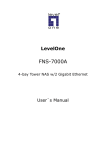
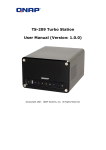
![Manual del usuario - [ [ [ ANSEL ] ] ]](http://vs1.manualzilla.com/store/data/006306298_1-4b727a9f513ab88544573091f86e1211-150x150.png)
